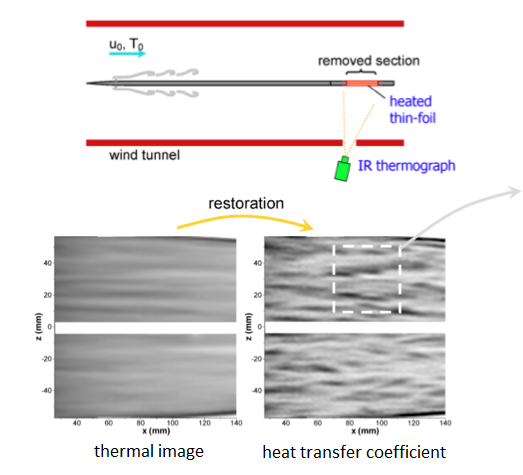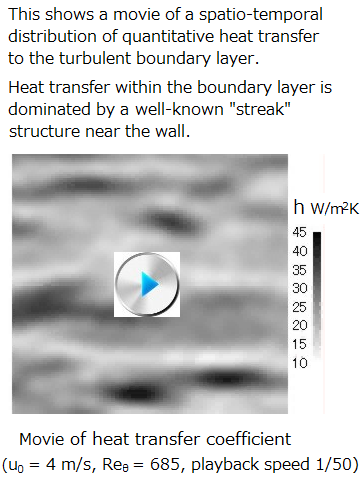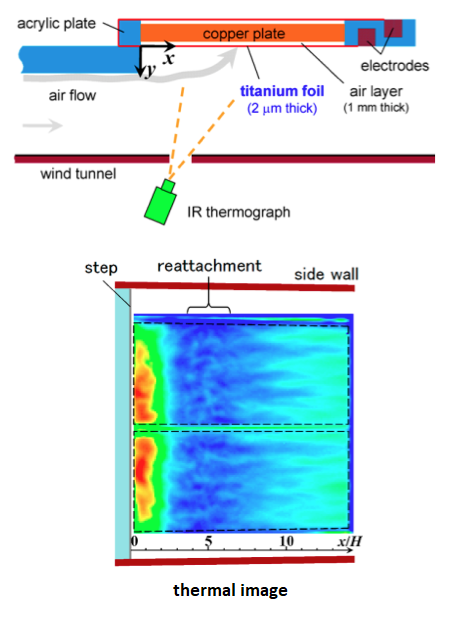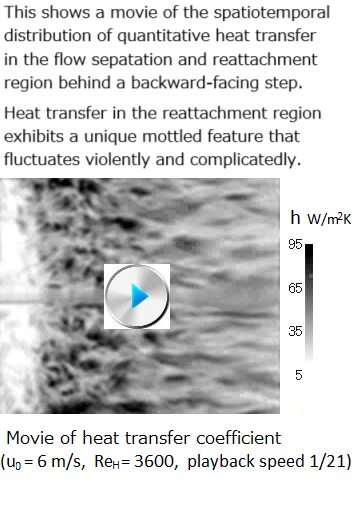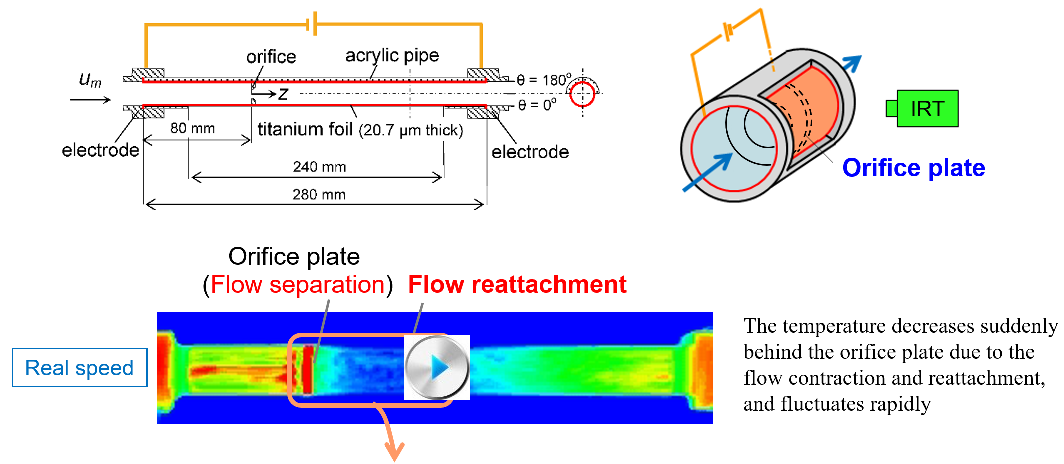Turbulent Heat Transfer Measurements Using Infrared Thermography
1. Principle
If a heated thin-foil is exposed to a fluid flow without contact with a solid surface, the temperature on the foil fluctuates according to variation of the heat transfer between the foil and the fluid. Thus, we can observe the spatiotemporal variation of the convective heat transfer reflected by flow turbulence by measuring the temperature fluctuation on the foil using high-speed infrared thermography.
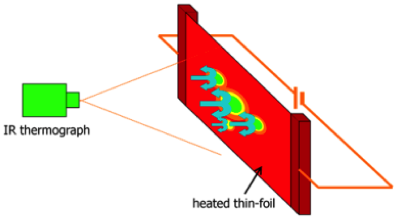
2. Frequency response and space resolution
If thermal inertia of the heated thin-foil is sufficiently small, we can observe the fast fluctuation of the heat transfer. However, if the fluctuation frequency becomes higher, the temporal amplitude attenuates and ultimately becomes indistinguishable from noise. Similarly, if thermal diffusion in the foil is sufficiently small, we can observe the fine spatial structure of the heat transfer. However, if the spatial structure becomes finer, the spatial amplitude attenuates and ultimately becomes indistinguishable from noise. In this work, heat conduction analysis was performed to derive general relationships between upper limits of both the fluctuating frequency and the spatial wavenumber of the heat transfer, which are detectable using infrared thermography.

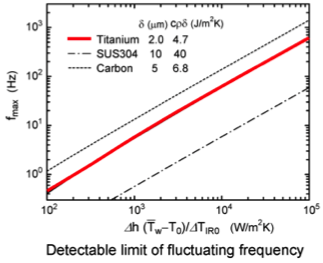
[main literature]
3. Measurement for turbulent boundary layer
To confirm that this technique can quantitatively measure heat transfer fluctuations due to flow turbulence, we attempted to measure the temperature fluctuations on the wall of a turbulent boundary layer using infrared thermography. Although the time and spatial fluctuation of the temperature attenuated due to the thermal inertia and thermal diffusion of the heated surface, the local and instantaneous heat transfer coefficients were quantitatively evaluated by heat conduction analysis of the heated surface. As a result, it was shown that the spatiotemporal fluctuations of heat transfer evaluated here are reliable when compared with the statistics with the existing experimental and numerical results. It was also clarified that the spatiotemporal structure of the heat transfer is dominated by the dynamic characteristics of turbulent vortex structure (streak structure). Accordingly, it was demonstrated that this technique is promising for investigating the unsteady nature of turbulent heat transfer to airflows.
[main literature]
- Measurements of Time-Space Distribution of Convective Heat Transfer to Air Using a Thin Conductive-Film, 5th Int. Symp. on Turbulence and Shear Flow Phenomena (2007) München, Germany, pp.773-778
- Quantitative Evaluation of Spatio-Temporal Heat Transfer to a Turbulent Air Flow Using a Heated Thin-Foil, Int. J. Heat and Mass Transfer, 64 (2013), 892-902
4. Measurement of separated and reattached flows
We measured spatio-temporal distribution of convective heat transfer accompanying flow separation and reattachment, such as a backward-facing step flow. Although the time-averaged characteristics of the heat transfer had previously been measured extensively, the present measurements have clarified the following: (1) The heat transfer in the flow reattaching region fluctuates violently and is highly nonuniform to have complicated mottled feature; (2) The instantaneous distribution of the heat transfer has quasi-periodicity of approximately a step height in the spanwise direction.
[main literature]
5. Measurement of water flow in a pipe
Focusing on the flow in a pipe, which is one of the most basic flow fields, we have measured the spatiotemporal variations in heat transfer caused by water flow inside a circular pipe. To date, we have performed the following: (1) Design and experimental demonstration of a test model which can quantitatively measure the spatialtemporal variation of heat transfer; and (2) Investigation of spatiotemporal fluctuations of heat transfer for separated and reattached flows formed downstream of an orifice. As a result, we clarified the mechanism by which the heat transfer coefficient is maximized upstream of the reattachment position of the flow, which has been a long-standing issue.
Subsequently, we have (3) Measured heat transfer fluctuations accompanying sudden acceleration and deceleration of the flow, and revealed that unique heat transfer fluctuations appear in each case of acceleration and deceleration. And showed that the variation of the heat transfer coefficient can be generalized by dimensionless formulas. Also, (4) Measured heat transfer fluctuations in swirling flow generated using a twisted tape insert, and showed that heat transfer increases significantly with respect to pressure loss. We are currently investigating the mechanism behind this.
【 主な文献 】
- Quantitative measurement of spatio-temporal heat transfer to a turbulent water pipe flow, Int. J. Heat and Fluid Flow, 63 (2017), 46-55
- Quantitative measurement of heat transfer fluctuation in a pipe flow around an orifice plate using high-speed infrared thermography, Mechanical Engineering Journal, 2-6 (2015), DOI: 10.1299/mej.15-00312
- Unsteady characteristics of turbulent heat transfer in a circular pipe upon sudden acceleration and deceleration of flow, Int. J. Heat and Mass Transfer, 113 (2017), 490-501
- Delay in response of turbulent heat transfer against acceleration or deceleration of flow in a pipe, Int. J. Heat and Fluid Flow, 85 (2020), 108661
- Consideration of Factors That Cause Heat Transfer Enhancement by Swirling the In-Pipe Flow in the Transition Regime, Proc. 17th Int. Heat Transfer Conf. (2023), ID: 333
